
by Annika Amundson and Hannah Vickers, 1st year students, MPhil Textile Conservation.
A fundamental aspect of textile conservation is to understand the techniques and technology behind the objects we conserve. While conservators don’t need to be experts in every technique encountered, a working knowledge of what holds the threads together certainly helps. As part of our MPhil Textile Conservation programme, we study textile techniques. On a recent class trip, we had the opportunity to see tapestry weaving first hand at the Dovecot Studios in Edinburgh.
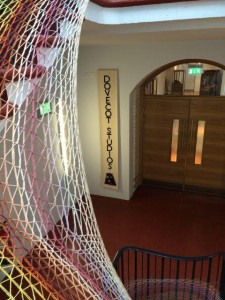
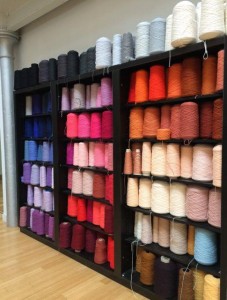
Images©University of Glasgow and courtesy of Dovecot Studios
Founded in 1912, Dovecot is now over 100 years old. The weavers moved into the current building, once a public swimming baths, in 2008. Removed of the water, the large, light-filled space makes an ideal home for the tapestry studio, overlooked by a viewing gallery for visitors to watch the weavers at work.
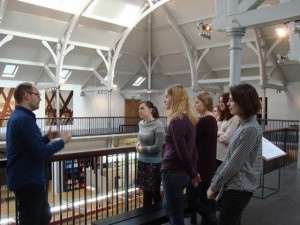
Jonathan Cleaver, a weaver at Dovecot, took us on a tour of the studio, giving us a rare opportunity to walk amongst the looms and get a closer look at the weaving process. The weavers work with clients to produce a viable design, which is drawn up into a scale size cartoon. The outlines are drawn directly onto the vertical warp threads, and then coloured weft threads are woven in horizontally. As they work, the weavers are constantly making decisions about how and where the colours meet and how far each thread is carried. The adaptation of the design into a tapestry is an organic process where the weaver interprets the design and decides how best to represent the artist’s intent.
In light of the huge investment of time devoted to making a tapestry, weavers need to consider the longevity of their work. Materials are chosen for their durability as well as suitability to their role. Cotton is usually used for the warp threads, which are not seen in the finished tapestry. They must provide a structural ground for the weft, which is usually of wool, traditionally chosen for its insulating properties and dye affinity. The weaver must also be able to work out how the design will affect the structure; the two are literally interwoven and an unsuitable composition can compromise the integrity of the whole structure. For example, a long boundary between two colours can create a slit that is sewn up. Over the life of the tapestry, the stitching can weaken, leading to gaps and distortion.
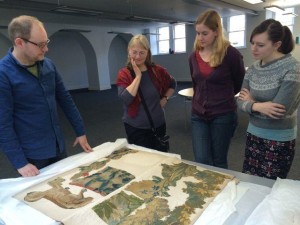
Examining historical tapestries can shed light on factors of their change and deterioration. At Dovecot we examined sample books from the archives, containing pieces from older tapestries going back as far as the seventeenth century. These can act as both sources of inspiration as well as educational tools. Structural changes, dye fading and areas of weakness for example, can all inform decisions in the creation of new tapestries.
Our visit to the Dovecot Studios gave us a fantastic insight into the weaving process, and will inform our decisions in the conservation of tapestries in the future. It revealed how the knowledge gleaned from the making of new tapestries and the conservation of old ones can inform one another. Although our roles may be very different, the longevity of tapestries is a concern shared by weavers and textile conservators alike.
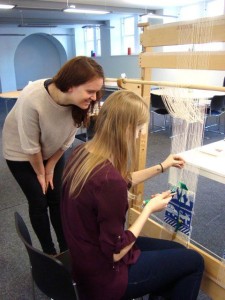
Many thanks to Jonathon Cleaver and fellow weavers for their kind hospitality and an inspiring visit.
Address: 10 Infirmary Street Edinburgh EH1 1LT
Opening Hours: Mon-Sat from 10.30 – 17.30

